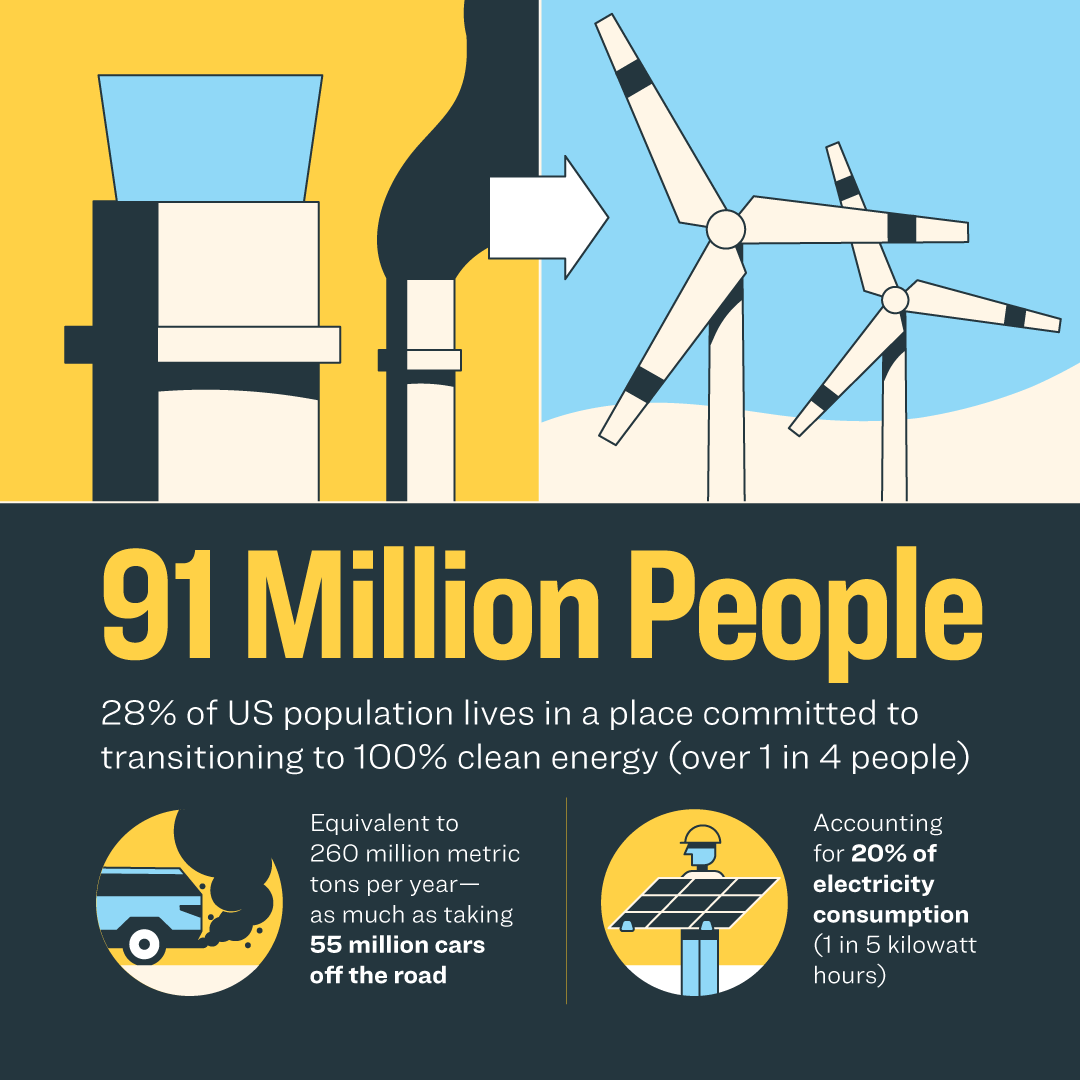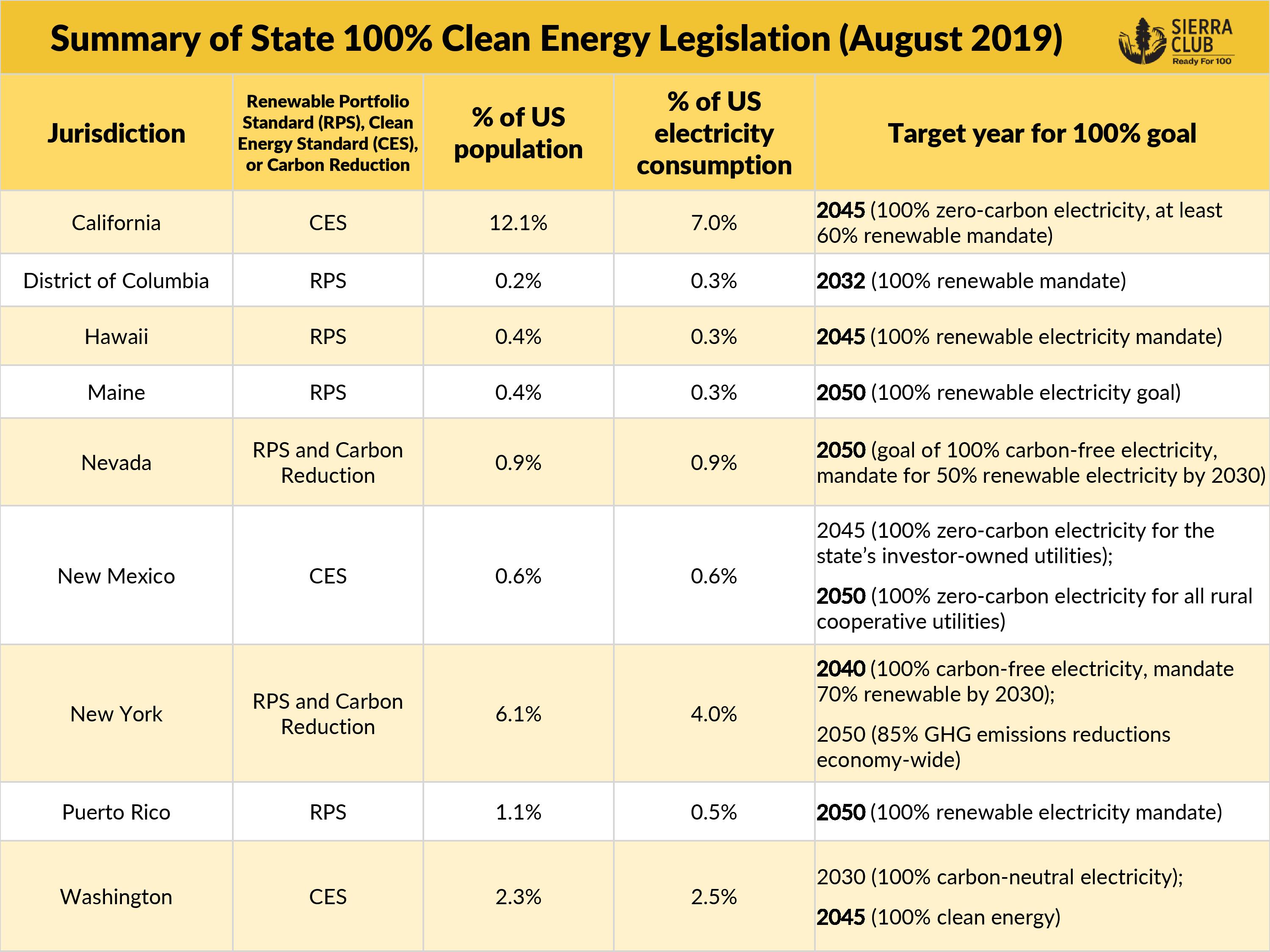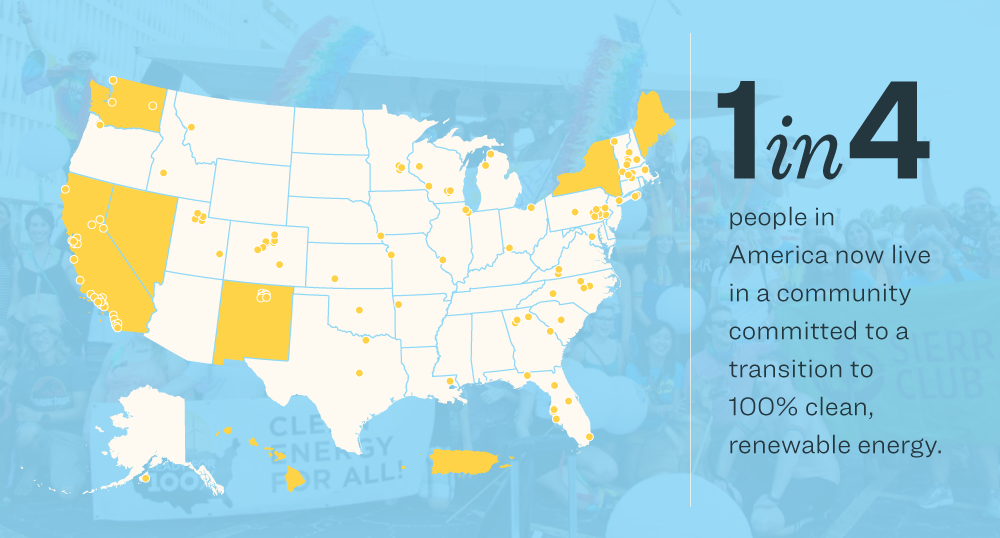Just three months ago, 1 in 5 people in the United States lived in a place that had committed to moving away from fossil fuels entirely and toward 100% clean electricity.
Today, that number is greater than 1 in 4.
In June, Maine, the 43rd-most populous state, and New York, the fourth-most populous state, both passed ambitious policies mandating a transition to 100% clean electricity. Now, 91 million people in the US (28% of the population), accounting for 20% of the country’s electricity consumption, will be powered by clean sources of electricity like wind, solar, and hydropower. All told, a switch to 100% clean electricity in these places will result in a carbon-pollution reduction of 260 million metric tons per year -- the equivalent of retiring 67 coal plants.

Sierra Club
The momentum has picked up exponentially in 2019, with five states joining Hawaii, California, and more than 130 cities aiming to decarbonize their power sectors.
Given how complex and convoluted the US energy system is, the pace at which ambitious clean energy policies have been written, adopted, and implemented across the country is remarkable. So, too, is the fact that the ambitious goal of 100% clean energy has become a central tenet in calls for climate action both in the streets and the halls of Congress.
One thing is clear: We’re in the midst of a revolution. As we move forward, creating a clean energy economy that serves 100% of the country will continue to be a chance to not only fix historic challenges in our communities but also build a better, safer, more-equitable world together.
So what’s happened already, and how are we going to make 100% clean energy everyone’s future?
States Are Following the Lead of Cities
Joining California and Hawaii, which were the only states with 100% goals prior to this year, are Maine, Nevada, New Mexico, New York, Washington, The District of Columbia, and Puerto Rico. See how these commitments stack up here.

Kass Rohrbach / Sierra Club
Although “100% clean energy” is now regularly debated in state houses and city halls across the US, this policy didn’t become the new normal spontaneously. In fact, for a long time, a complete transition from all dirty fuels seemed implausible to pundits, grid experts, and even those in the climate movement, even as clean energy was (and continues to be) supported by vast swaths of the public.
Grassroots demand made 100% clean energy the true movement that it is. This movement toward 100% started more than a decade ago, when college students began demanding commitments from their universities, and when corporations, responding to customer pressure, began making commitments and driving real, new investments in the clean energy market. If it weren't for this movement of everyday people -- students, business owners, artists, faith leaders, parents, grandparents -- who continue to demand a just and equitable clean energy transition in their communities, this mandate would not be the unignorable imperative that it is today.
In the last three years, cities have stepped up to match the leadership of institutions and businesses and today 132 committed cities and 11 counties represent 7% of the overall demand for a transition to clean energy. While only seven states have adopted this goal to date, cities, counties, and towns in every corner of the country have made commitments.
At the end of 2016, fewer than 25 cities had set targets to leave fossil fuels behind and go all-in on clean electricity. Now, more than 25% of the US population live in places that are committed to 100% clean energy.

Data sourced from 2016 census. View on Tableau Graph by John Romankiewicz / Sierra Club
Beyond Commitments
States are regularly setting 100% Renewable Portfolio Standards (RPSs) as utilities like Idaho Power, Xcel Energy, and Green Mountain Power recognize the cost-effectiveness of transitioning away from fossil fuels. Cities are planning for their local energy transition. Leaders in Congress are taking note.
And yet: Greenhouse gas emissions are still rising, millions of people breathe dirty air, and energy burdens plague many American households, disproportionately hurting low-income people. Merely setting goals is not the end goal by any stretch. Threats to cleaner, healthier, and cheaper energy and a stable climate abound left and right: Utilities are looking at dirty fracked gas as a “bridge fuel” when the technology to go all-renewable is already here; the fossil fuel industry is spending billions of dollars to protect its polluting interests and defy our democracy; frontline communities, which are hurt first and worst by climate disruption and pollution, remain at risk.
Now is not the time for empty promises or kicking the can down the road. This is the hard part: Making the change we want to see happen and doing it the right way.
Business as usual is unacceptable if we’re to meet the many economic, racial, and environmental justice crises at hand. In pursuing an energy transformation, every person in every community must benefit from a new clean energy economy -- otherwise, we won’t have succeeded much for anyone.

Sierra Club
Long-Term Vision
Clean energy progress is mounting. Here are the facts:
-
Solar installers and wind technicians are the fastest-growing jobs in the US.
-
Electricity from renewable sources just surpassed coal for the first time.
-
Renewables like solar and wind are the cheapest source of electricity across most of the world -- ahead of coal and gas.
-
Globally, the number of cities powered by at least 70% renewable electricity more than doubled between 2015 and early 2018 (from 42 to 101).
-
In the US, 85% of people support 100% clean energy.
This year alone, we’ve seen states assume the mantle of clean energy leadership by making big commitments to clean energy. To get to 100% from here, our challenge and charge will be to support our city and state leaders in implementing the goals that they have set, continue to secure commitments across this county, and ensure that it’s done right without leaving anyone behind. Thriving communities, strong union and family-sustaining clean energy jobs, and clean air and water for all: This is what we can create through a just and equitable transition to 100% clean energy.
We’re just getting started. Will you join us?
